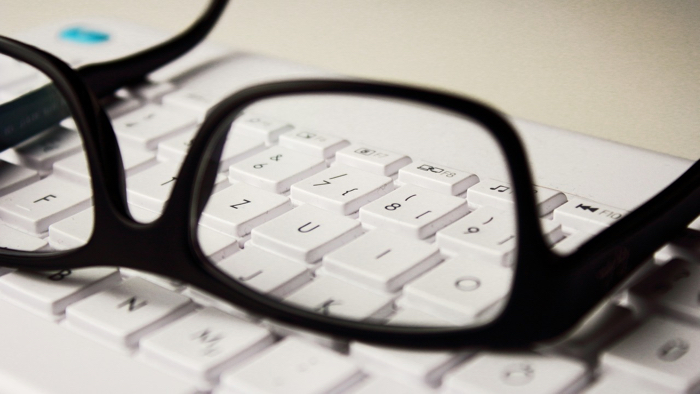by Jessica Price
You’ve seen the ads, heard the claims, and now you’re wondering
if these blue-light blocking glasses are for you.
Do you really want to haul out your blue-light blockers every time you sit down to write? What if you don’t write from home? Just another thing to lose at coffee shops, libraries, or your 9 to 5.
Then, there’s the fact that you have to remember to wear them every day to see any benefit. Ugh.
First world problems much?
But really.
Think about it this way — you stare at a computer screen for eight or more hours throughout the workday.
Then add in your phone screen time. Tablet screen time. TV screen time. I’m not sure I’m even willing to admit how many hours I spend looking at screens, are you?
But one thing is crystal clear—eye strain is real. The headaches set in, and you can see it in your eyes when you’ve had too much screen time.
Are your headaches and eyestrain caused by blue light? Do you find yourself thinking throughout the workday about how strained your eyes feel and yet, you know you aren’t tired?
All you want and need is to meet that deadline and look good doing it, dang it.
Is Blue Light the Cause of Eyestrain?
Scientists are still working to determine whether excessive screen time can cause direct damage to those baby blues, but we do know that long-term exposure to blue light from our devices causes digital eye strain.
Digital eyestrain is exactly as it sounds, meaning you’re staring at your devices, blinking less than normal, and ending up with dry, strained eyeballs throughout your day.
Surprisingly, the sun is the largest source of blue light. In the morning, blue light helps wake you up and gets you going.
Where you can get into trouble is your screen time in the evening and night. Blue light largely affects your circadian rhythms.
You know to limit screen time within a couple of hours before hitting the hay, but how often do you follow that recommendation?
It’s true — scrolling through Instagram, Facebook, and Pinterest all night can throw off your sleep habits.
While social media lures you in, you also have real work to get done at night on your devices. Shout-out to any entrepreneurs hustling late into the night after their 9 to 5!
As a writer, you’re especially prone to eye fatigue from a job that is done mostly on your laptop. Blue blockers can help relieve that stress so you can focus on your work and land your dream client!
You have blogs to write, content to create, and audiences to connect with. You should be able to achieve these goals without ending up with a screaming headache and without sacrificing good, quality sleep.
Blue-Light Blocking Glasses Can Make Writing Easier
If you still aren’t convinced, the bottom line is to protect your eyes from blue light and digital eyestrain so you can keep on, keeping on.
Incorporate frequent breaks from screens every 20 minutes and invest in some artificial tears to avoid any dryness.
And if/when you get sick of staring off into space so often — invest in yourself and some blue-light blocking eyewear to alleviate eyestrain, work on your writing with no drawbacks, and sleep like you’ve never slept before. Queue — all the praise hands.
If you have read this far, you are probably wondering where to find a pair of blue blockers to test out for yourself.
Good news! There are a ton of options out there, and the convenience of online stores could have your blue blockers at your doorstep in just a few days.
When you start your search, you’ll first notice the different tints available. As a general rule of thumb, lenses range from colorless to an amber tint. The darker the tint, the higher the percentage of blocked blue light.
If you are looking to limit exposure to blue light at night, you could consider a darker lens to block out blue light the best. Think about when you want to wear your glasses and that will be a great starting point for choosing your lens tint.
Where Writers Can Find Blue-Blocking Glasses
If you’re someone that likes to try on glasses before buying, check out Target and you can find a generic pair for around $20.
Amazon is going to provide the most variety at your fingertips. A popular name brand, Swannies Blue-Light Blockers, has a variety of tint options and will run you around $70. There are also some colorless lens options on Amazon that will cost around $20—$30. For this option, I would check out reviews before purchase!
I got my blue blockers through Zenni — I added the blue-blocking option to my regular prescription glasses order. So easy. I was due for a new pair, so I thought why not? And I am loving them!
My Zenni single vision prescription glasses with blue-blocking lenses added cost me $60. Looking through the choices, you can easily see this is a doable investment for a better night’s sleep, fewer headaches, and decreased eye strain.
Other Options for Blocking Out Blue Light
There are other ways to block out blue light besides blue-light blocking glasses.
For starters — check out your display settings on your phone and computer. Both should have a version of “night mode” that you use or can even set-up to turn off and on automatically. This will be a step in the right direction for your digital eyestrain.
You can also get physical screens to go over both your phone and your monitors to help block out blue light. Technology, am I right?
With these options, even without blue blockers, you will notice a significant difference with your eyes.
Decisions, decisions.
You know you want them — and you deserve it! I can’t wait for you to try out your first pair of blue-light blocking glasses.
Have you tried blue-blocking glasses?
* * *
 Jessica Price is an obsessed dog mom and total lab nerd. With a passion for the healthcare industry, Jessica strives to create strategic content for her clients through her medical copywriting business, Jessica Price Agency. Her background and expertise give her the upper hand, and you can guarantee you’ll have a top-notch experience with her services.
Jessica Price is an obsessed dog mom and total lab nerd. With a passion for the healthcare industry, Jessica strives to create strategic content for her clients through her medical copywriting business, Jessica Price Agency. Her background and expertise give her the upper hand, and you can guarantee you’ll have a top-notch experience with her services.
When Jessica isn’t writing and researching, you can find her at the local coffee shop or trying out new restaurants with her husband, Trey.
For more information about Jessica and her work, please see her website or connect with her on LinkedIn.
Source
AAO. “Should You Be Worried About Blue Light?” American Academy of Ophthalmology. Last modified October 18, 2018. https://www.aao.org/eye-health/tips-prevention/should-you-be-worried-about-blue-light.

